Stand up paddle boarding — what’s not to love? Boarding can be relaxing and meditative on calmer days, and make for some thrilling adrenaline rushes on others. There’s something for everyone — drifters, paddlers, and surfers alike. Chances are you’re already smitten with a SUP that caught your gaze. You can already imagine what it would be like to drift, paddle, or catch some waves on it. Plus, the thing looks terrific! Conversely, maybe you already own the beautiful SUP of your dreams and are now looking to upgrade it with fresh gear — more specifically, some SUP fins. Regardless of whether you already own your SUP or are still in the buying phase, you’re here because you have questions. Fortunately, we have answers.
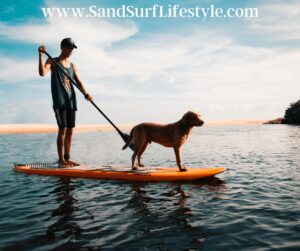 When you select or upgrade your SUP, you’re also determining your boarding experience. That’s why, when picking out your fins, you’ll want to know which ones are the best for you, your board, and your needs. When choosing a SUP fin, it’s critical to understand the following:
When you select or upgrade your SUP, you’re also determining your boarding experience. That’s why, when picking out your fins, you’ll want to know which ones are the best for you, your board, and your needs. When choosing a SUP fin, it’s critical to understand the following:
1) Why SUP fins matter. Without them, maneuverability, tracking, and stability become nearly impossible.
2) Why selecting just any random SUP fin(s) is inadvisable. Picking out a fin simply because it’s easy is a mistake that should be avoided at all costs. Your gear can either make or break your control, safety, stability, and experience depending on what it is you’re seeking to do on your SUP. Investing the time and care necessary into selecting the right fin(s) is better not only in the present but in the long term as well.
3) When to start thinking about SUP fins. As most are detachable and a majority of SUP boards accommodate this system, it’s never too early or too late to be thinking about which fins to buy. As soon as you know what board you want, it’s already time to start thinking about which corresponding SUP fins will be your best fit.
4) The material and construction of your SUP, and how it impacts which fins you buy. If you have a solid board, you’ll want fins made for solid boards. If you have an inflatable board, you’ll want fins made for inflatable boards.
5) How the size of your SUP fin plays into your experience. Large fins are usually better for tracking and stability, small ones excel in maneuverability, and medium ones incorporate elements of both.
6) How many fins to buy. This comes down more to your own personal SUP goals and the best fin configuration(s) for achieving them. Flatwater paddlers and certain beginners might prefer the one fin configuration, which is great for tracking and lesser drag. Boarders of all levels might instead go for the three-fin configuration, which is an improved version of the twin fin configuration and provides better control and stability across various water conditions and activities. Finally, SUP surfers might prefer the two and one configurations, which optimizes speed and control in rougher waters.
Why SUP Fins Matter
You might be asking — do SUP fins really matter? Well, that’s a terrific question with a terrific answer. Yes, SUP fins really do matter. They matter a lot.
A board is just a board without certain add-ons, and successfully steering a big block of material — inflatable or otherwise — through temperamental waters can be extremely challenging without the correct fins. SUP fins allow you to steer, maneuver, and understand where you and your board stand in the water.
Why Investing the Time and Effort into Choosing the Right SUP Fin(s) Matters
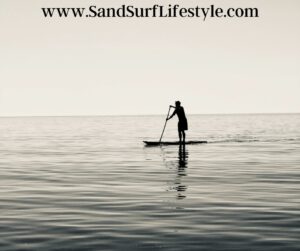 Maybe this entire process feels annoying, or even impossible. If so, then you’ve probably already wondered — should I just buy some random SUP fins now and worry about how they play out later?
Maybe this entire process feels annoying, or even impossible. If so, then you’ve probably already wondered — should I just buy some random SUP fins now and worry about how they play out later?
That’s another terrific question, but this time with a slightly less terrific answer: no. When it comes to selecting equipment for any activity or sport, least of all one that you’ll be doing in the vast ocean, you never want to randomize. Selecting the right gear can be the line between enjoyment and misery, or even life and death.
While it might feel tempting to skip the selection process, you’ll be happier you went through the trouble and picked out the right fins for your board and corresponding boarding needs. Sometimes you might get lucky with choosing whatever seems the cheapest, easiest, or most accessible, but more often than not, you’ll just end up frustrated and out of some money you’ll wish you hadn’t wasted on any random pair of fins. You might even get injured by pairing the wrong fins to the wrong board, the wrong fins to the wrong ocean patterns, or else the wrong fins to the wrong type of boarding activity.
When to Start Thinking About SUP Fins
Now, if you’ve already bought your board, you might be worried that it’s already too late for you to be thinking about SUP fins. Believe it or not, it absolutely isn’t! While some SUPs might come with fins already built-in, the more popular option is the removable kind.
With removable fins, you can actually switch them out depending on your present needs. This also makes for easier board storage and permits you to experiment with numerous types and configurations. Moreover, already knowing which board you’re looking to pair your fins with can stop you from matching up gear that shouldn’t really go together.
Even if you are still only considering buying a board with pre-matched fins, and even if you did so already, be sure to keep reading. Just because your SUP and fins are sold together doesn’t always mean they go together. Humans — even water sports manufacturers — are fallible. It’s better to know these things for yourself so you can avoid unnecessary inconveniences and incidents while boarding.
Are 3 Fins Better Than 1 On A Paddle Board? Find Out Here.
Why SUP and Fin Material Matter
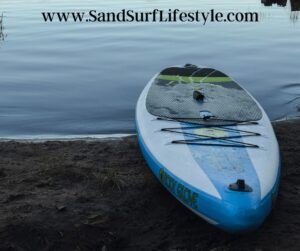 Do SUP and fin material matter? Yes, they sure do! While we won’t get into the details of choosing an actual SUP here, we will tell you a bit about how the material of your board impacts the fins you buy.
Do SUP and fin material matter? Yes, they sure do! While we won’t get into the details of choosing an actual SUP here, we will tell you a bit about how the material of your board impacts the fins you buy.
Basically, there are two main types of SUPs: solid and inflatable. Solid boards involve a variety of materials. Some have EPS foam and fiberglass. Others have carbon fiber. Others still are made of plastic. Occasionally, you’ll even stumble across some which use a touch of wood to achieve that classic, traditional aesthetic.
Most standard fins intended for non-inflatable boards should work well with solid SUPs and hold up properly. What you don’t want to do, however, is match a solid SUP with fins intended for inflatable SUPs, or else an inflatable SUP with fins intended for solid ones.
That’s because inflatable SUPs have an entirely different construction which cannot hold solid board fins well. Reversely, inflatable board fins are not strong enough to steer a solid SUP adequately. Inflatable SUPs utilize specific, synthetic, PVC material for the exterior. The core is air, achieved through the use of a pump before boarding. That’s why metal fins go with solid SUPs, and rubbery, somewhat more flexible fins go with inflatable ones.
Regarding which material base is optimal, there are pros and cons for both, and solid SUPs do come more highly recommended for ocean boarding. Either way, both solid and inflatable constructions have their merits. It just comes down to each boarder’s needs and preferences.
Something selecting a SUP and choosing its corresponding fins have in common, however, is the primary considerations involved in doing so. List your wants and needs for your SUP and/or fins in descending order, then select your SUP and/or fins accordingly. Fit, performance, safety/stability, storage, and the importance of each to you are all worth noting.
Determining the Size(s) of Your SUP Fin
Does the size of your SUP fin matter? It does, or at least, it should — especially if you’re looking to surf with your SUP. For better tracking and stability, wider-based, larger-sized fins are preferable. However, narrower-based, smaller-sized fins also have their uses — mainly, navigation control. If you want tracking, stability, and maneuverability all in one, the in-between sizes are your best bet, so long as you’re alright with medium performance in these areas.
Of course, these are simply rules of thumb. Different shapes and bases can change the very nature of a fin, regardless of size. In other words, if you’re not sure, it’s best to ask a salesperson or manufacturer for assistance.
How Many Fins to Buy, and In Which Configuration(s)
How many fins you buy, and in which configuration(s), entirely depends on you, your board, and your intended SUP activities. There are more options than we can list in this article, so we’ve picked out the most common fin configurations for you with a brief explanation for each. Even though these are written more with solid SUPs and their corresponding fins in mind, these same variations are generally available for inflatable board ones as well.
The Single Fin Configuration
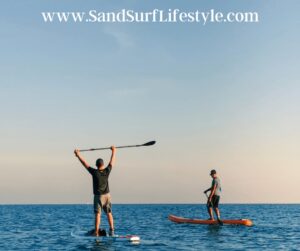 First and foremost is the single fin configuration. Many SUPs already come paired with a single fin. Here, you’d have a finbox with a single fin in it, and everything would already be screwed into place to avoid any mishaps. Nevertheless, there should be space in there specifically for the fin to move along a specific path, therefore allowing it to help maneuver you and your SUP through the water.
First and foremost is the single fin configuration. Many SUPs already come paired with a single fin. Here, you’d have a finbox with a single fin in it, and everything would already be screwed into place to avoid any mishaps. Nevertheless, there should be space in there specifically for the fin to move along a specific path, therefore allowing it to help maneuver you and your SUP through the water.
The single fin is ideal for those, specifically flatwater paddlers, searching for SUP fins providing great tracking without the drawback of too much drag. This is the most practical approach, and especially great for starting out. Still, the single fin configuration shouldn’t be underestimated by those on a more intermediate level. All types of SUP fins have their merits, and all are worth considering regardless of current skill level.
The Three Fin Configuration
This configuration is also sometimes known as the “thruster fin” setup. The three fin surf configuration, invented in the 1980s by Simon Anderson, served as a response to a prior lack of stability in big waters. This was a result of the popular 1970s “twin fin” surf setup.
Of course, the twin fin configuration, consisting of just two [identical] fins, was vital for providing a better understanding of drift, drag, direction, tracking, control, and speed in the sport. However, and despite being sturdier than the single fin configuration, the stability it provided wasn’t ideal, and limited boarders to small and medium surf conditions.
Here, with the “thruster” configuration, you have three fins, and they’re all more or less about the same shape and size. It adds to the twin fin model by adding an extra fin at the end of the tail and between the other two (the so-called “twin fins”) for improved stability. With this configuration, boarders can catch larger waves.
The three fin setup is great for boarders of all levels, and allows for movement in a variety of conditions. In terms of control and stability, this configuration works for both flatwater sports and for surfing. Its main setback, however, is that the third fin (the one at the back) adds additional drag, therefore slowing things down.
 The Two and One Configuration
The Two and One Configuration
For those looking to surf on their SUPs, the two and one fin setup is among the most popular. Almost an intermediate in-between, although slightly more advanced form, of the twin and three fin configurations, the two and one utilizes three fins for optimal speed and control — especially while surfing.
Here’s how it works. Basically, to start, you have a pair of “twin fins.” You also have that third fin, but instead of it being entirely or nearly similar in size to the other two, it’s much larger. This third fin goes directly in-between the other two fins. This engineering provides for a variety of options regarding SUP use but, as mentioned before, is best intended for those looking to surf on their boards.


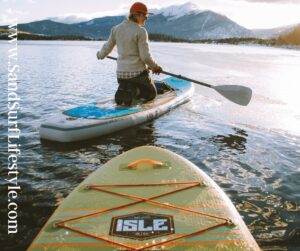 The Two and One Configuration
The Two and One Configuration